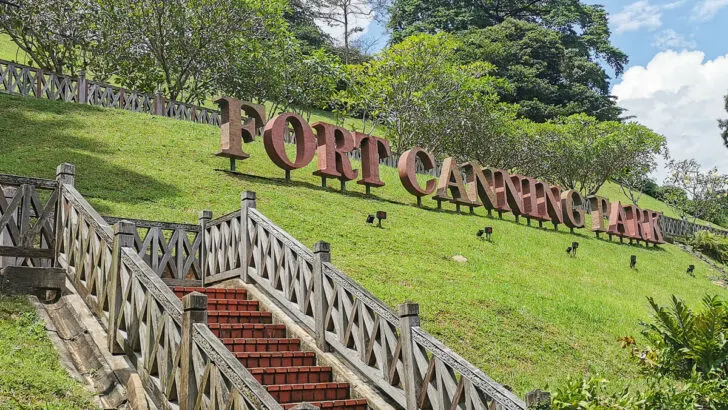Nestled between the bustling districts of Dhoby Ghaut, City Hall and Clarke Quay, the Fort Canning Park is truly one of the most underrated places to visit in Singapore.
Most people often associate Fort Canning Park with the infamous Tree Tunnel, and rightfully so, but the tunnel is just a small part of the park. Fort Canning Park has a lot of hidden gems.
There are myriad of historical artefacts, manmade beautiful landmarks and scenic viewpoints in Fort Canning Park that most people are not aware of (my best guess is that most people are put off by the number of stairs they need to climb within the park).
In this comprehensive guide, I’ll share the many ways to get to Fort Canning Park, what to do, what to eat, what to bring and wear, the facilities and the nearby places of interest.
If you’re wondering how long it takes to explore the park, well, for me, I wasn’t able to explore the entire park within one day because it’s so huge and my energy ran out before I’ve finished ticking off my list.
If you’re short on time, I suggest that you shortlist the places that you really want to go and just focus on your shortlist.
TABLE OF CONTENT
1. Brief History
2. Opening Hours
3. How to get to Fort Canning Park
4. What to Bring
5. What to Wear
6. Facilities
7. Things to do in Fort Canning Park
8. What to eat at Fort Canning Park
9. Nearby Places of Interest
💡 Looking for ideas on what to do in Singapore? Read my complete guide to the best things to do in Singapore.
1. History
Before writing about the modern Fort Canning Park that we know today, I’d like to walk you down the memory lane and share a brief history of the park.
Fort Canning Park was formerly known as Forbidden Hill (or “Bukit Larangan” in Malay) as it was believed to be where the ancient kings lived and were buried, and that it was not accessible by commoners.
When Raffles arrived in Singapore, he built his residence in 1822. His home was later renamed Government House; and the hill became known as Government Hill or Singapore Hill.
In 1859, due to security concern, the Government House was demolished and a military fort was constructed. In 1861, the hill was renamed to Fort Canning after the completed fort and Viscount Charles John Canning, who was the Governor-General and First Viceroy of India.
The fort was later used by British Army and Japanese Army during their occupation. After World War II, British resumed control of the fort until 1963, when they handed over Fort Canning to the Singapore Armed Forces (SAF).
In 1972, SAF vacated the hill and it was turned into a public park called Central Park.
In 1981, Fort Canning was renamed to Fort Canning Park with the planting of a fruit tree by then prime minister Lee Kuan Yew.
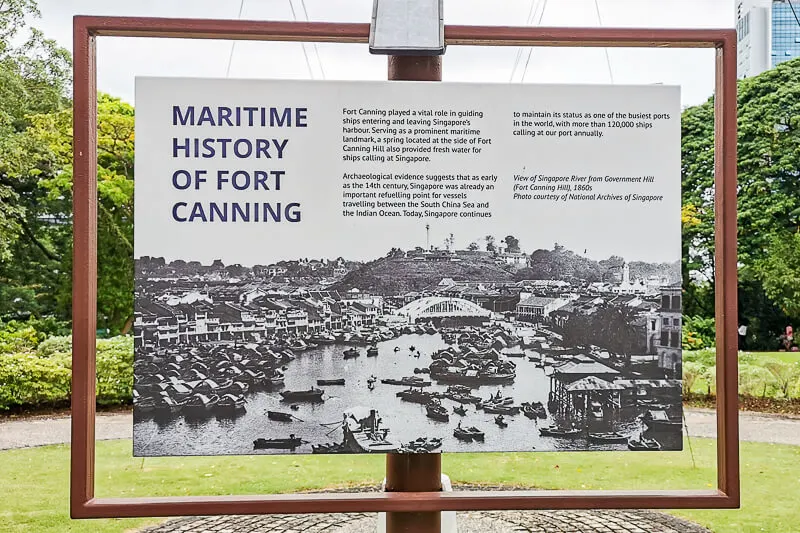
Have any questions about traveling in Singapore? Join All About Singapore Travel FB group, I'll be there to answer your questions!
2. Operating Hours
Fort Canning Park is open 24/7. Lighting hours are from 7am to 7pm daily.
The Battlebox is open from 9.30am to 5.30pm on Fridays-Sundays and Public Holidays. It is closed on weekdays except Public Holidays.
Fort Canning Heritage Gallery is open from 10am to 6pm daily (except the last Monday of each month).
Restaurants have their own opening hours. Refer to their websites for latest opening hours.
3. How to get to Fort Canning Park
The easiest way to get to Fort Canning Park is by taking MRT to Fort Canning Park Station (Downtown Line). Take Exit B.
However, you can also take MRT to one of the following MRT stations and walk a short distance to Fort Canning Park:
– Dhoby Ghaut Station (North South Line, North East Line and Circle Line), Exit B
– Bras Basah Station (Circle Line), Exit C
– Clarke Quay Station (North East Line), Exit E
Fort Canning Park has more than 10 entrances. Some are accessible by public transport, some has carpark, some requires you to climb tall staircases, some has escalators. Refer to my illustration and table below.
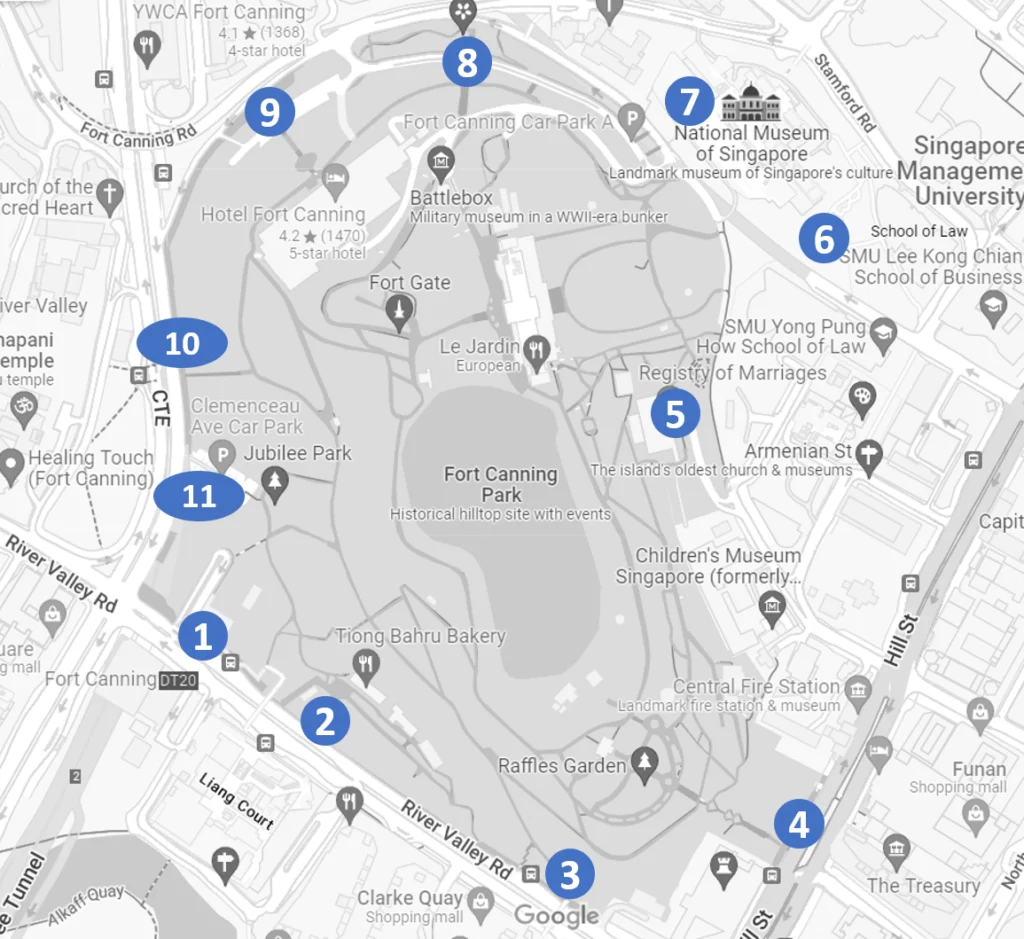
List of entrances at Fort Canning Park:
1. Fort Canning MRT (Location)
Road Name: River Valley Road
Public Transport: MRT, Bus
Carpark: No
Escalator: Yes, but suspended
Stairs: Yes
2. The Foothills (Location)
Road Name: River Valley Road
Public Transport: MRT, Bus
Carpark: No
Escalator: No
Stairs: Yes
3. Opposite Clarke Quay
(Location)
Road Name: River Valley Road
Public Transport: Bus
Carpark: No
Escalator: No
Stairs: Yes
4. Old Hill Street Police Station (Location)
Road Name: Hill Street
Public Transport: Bus
Carpark: No
Escalator: No
Stairs: Yes
5. ROM Carpark (Location)
Road Name: Canning Rise
Public Transport: –
Carpark: Yes
Escalator: No
Stairs: Yes
6. Stamford Green / SMU (Location)
Road Name: Stamford Road
Public Transport: MRT, Bus
Carpark: No
Escalator: Yes
Stairs: No
7. National Museum of Singapore (Location)
Road Name: Stamford Road
Public Transport: MRT, Bus
Carpark: Yes
Escalator: Yes
Stairs: No
8. Fort Canning Park Tree Tunnel (Location)
Road Name: Penang Road
Public Transport: MRT, Bus
Carpark: No
Escalator: No
Stairs: Yes
9. Hotel Fort Canning (Location)
Road Name: Clemenceau Ave
Public Transport: Bus
Carpark: Yes
Escalator: No
Stairs: Yes
10. Pancur Larangan (Location)
Road Name: Clemenceau Ave
Public Transport: Bus
Carpark: No
Escalator: No
Stairs: Yes
11. Clemenceau Ave Car Park (Location)
Road Name: Clemenceau Ave
Public Transport: MRT, Bus
Carpark: Yes
Escalator: Yes, but suspended
Stairs: Yes
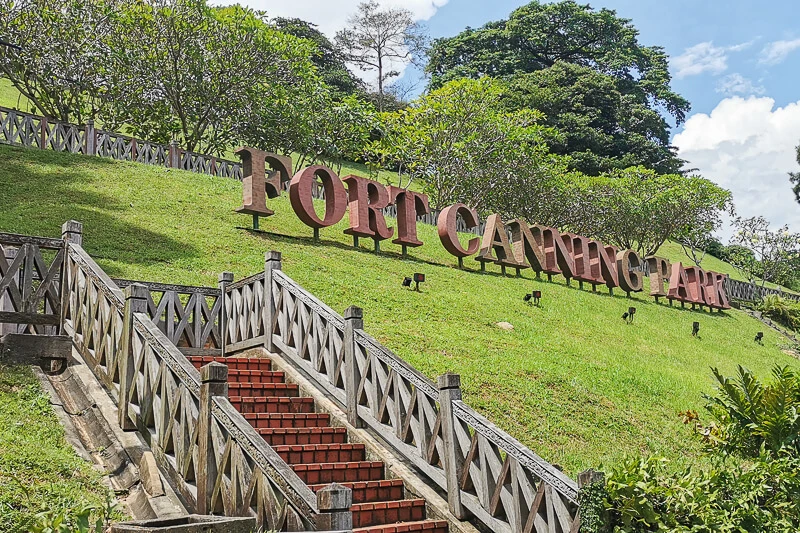
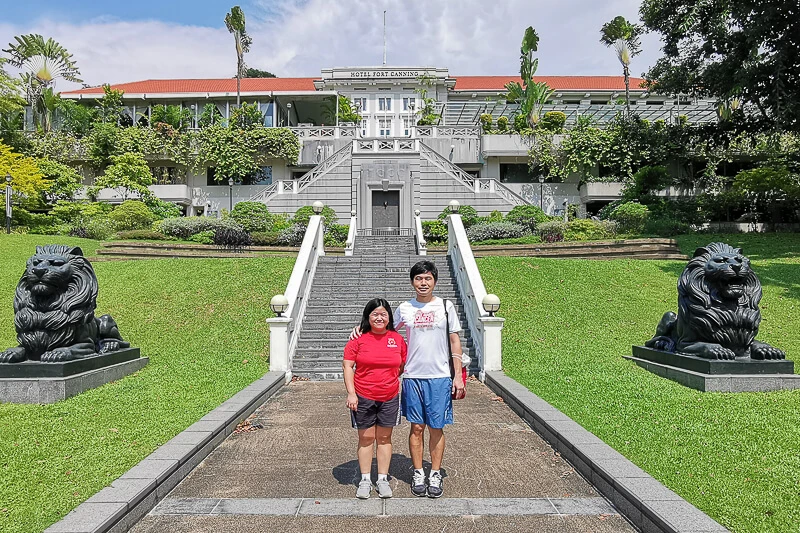
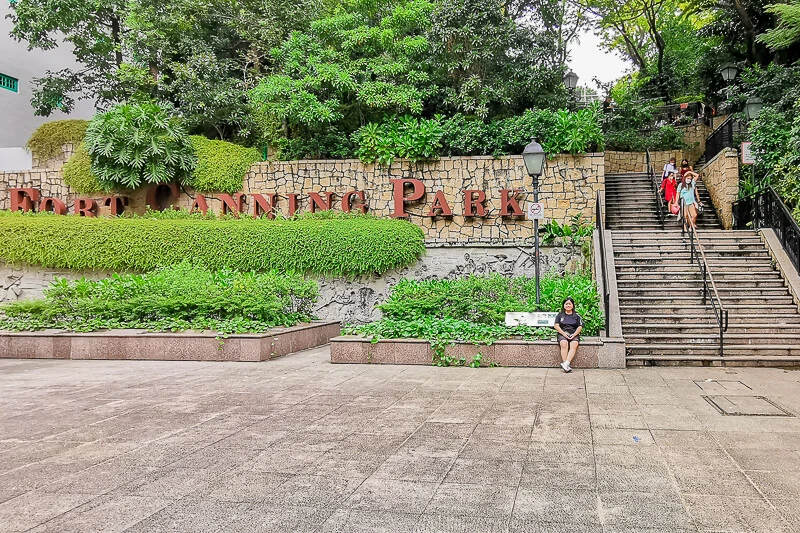
4. What to Bring
Water. The park is really huge and considering the number of stairs you need to climb, I highly recommend that you bring your own drink.
There is no convenient store at the park. If you don’t bring your own drink, your options would be vending machine at the toilet near Fort Canning Lighthouse or buy drink from restaurants (see “What to eat” section further in the article).
Mosquito repellent. Unless you’re wearing long pants and long sleeve shirt, or you’re moving really fast, there’s possibility that you get mosquito bites, so do apply mosquito repellent or mosquito patch.
Umbrella/raincoat. There are not many shelters at Fort Canning Park, if you’re planning to spend a long time there, do bring umbrella or raincoat, especially during rainy season.
Sunblock. Fort Canning Park is mostly unsheltered, do wear sunblock to protect your skin if you’re planning to spend a lot of time at the park.
5. What to Wear
If you’re planning to explore the entire park, or a large portion of the park, I highly recommend that you wear shoes for your comfort.
Most of the footpath is made of bricks, and there will be plenty of stairs, so a good pair of walking/road running shoes will suffice. Trail shoes is not required.
6. Facilities
In this section, I’ll compile all of the facilities and their location in Fort Canning Park, for your easy reference.
Carpark:
– Carpark A at Canning Walk (Location)
– Carpark B at Percival Road (Location)
– Carpark C at Fort Canning Hotel (Location)
– Carpark at Clemenceau Ave/Jubilee Park (Location)
– Carpark at Registry of Marriage (ROM) (Location)
Toilet:
– Toilet at The Foothills (Location)
– Toilet near Fort Canning Lighthouse (Location)
– Toilet at Fort Canning Hotel for hotel guests (Location)
– Toilet at Le Jardin for restaurant guests (Location)
– Toilet at Fort Canning Centre (Location) – under renovation
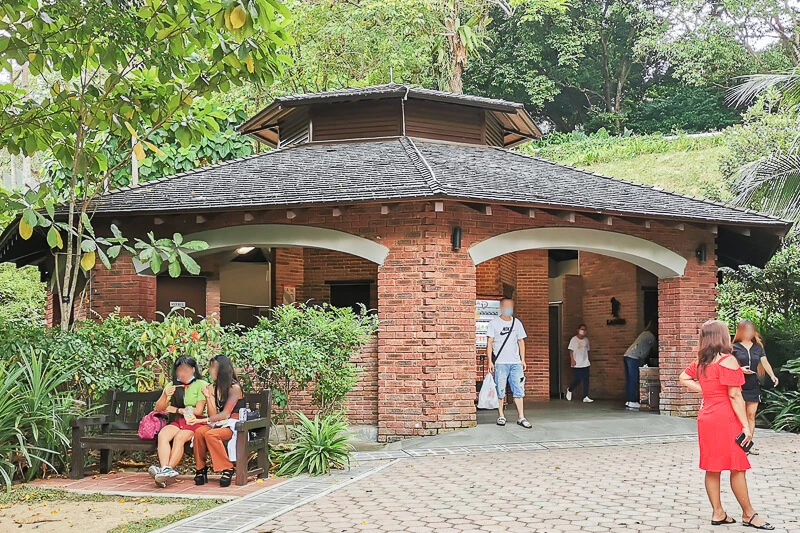
Drinks:
– Vending machine at toilet near Lighthouse (Location)
Food & Drinks:
– Tiong Bahru Bakery at The Foothills (Location)
– Le Jardin at Fort Canning Centre (Location)
– Tisettanta Lounge at Fort Canning Hotel (Location)
7. Things to do in Fort Canning Park
Fort Canning Park Tree Tunnel
The most popular spot in Fort Canning Park is undoubtedly the Tree Tunnel. It is an underground tunnel that connects Fort Canning Park and Penang Road (near Dhoby Ghaut MRT).
The easiest way to get to Fort Canning Park Tree Tunnel is to go to Dhoby Ghaut MRT Station, take Exit B, walk across the lawn until you reach the bus stop.
Then, cross the street (Penang Road) and you’ll arrive at UBS Building. Turn left and walk along Penang Road towards the Tree Tunnel. This is the location on Google Maps.
Many people come here to take wedding photoshoot or just casual photoshoot. It gets very crowded on weekends, and you might have to queue to take photographs at this infamous spot.
If you’re planning to take a photo here, it’s good to brainstorm a few angles and poses in advance. I didn’t plan any angle and pose, and this is the result: a photo of my head, without my body!
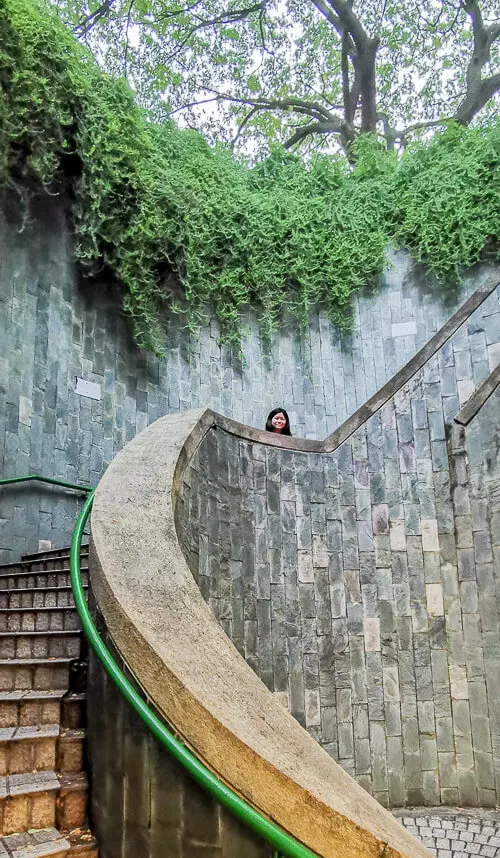
The Battlebox
The Battlebox, formerly known as Fort Canning Bunker, was a British underground command centre during the World War II. Built between 1936 – 1941, the bunker is 9m deep and had over 20 rooms.
In 1942, British and the Allied forces made the decision at Fort Canning Bunker to surrender to the Japanese forces. The bunker was later occupied by Japanese forces.
After Japanese surrendered in 1945, British came back and decided to seal the bunker instead of resuming operations.
Today, the Battlebox underground command centre has been restored to replicate the final days before Singapore fell to the Japanese forces.
The Battlebox is open from 9.30am to 5.30pm on Fridays-Sundays and Public Holidays. Ticket costs S$20 for adults, and S$10 for children. Tickets can be purchased on the spot or online. Book your ticket online here.
Each admission includes a 30-min guided tour. Photography and videography are not allowed inside The Battlebox. There’s NO free admission for Singapore Citizens and PRs.
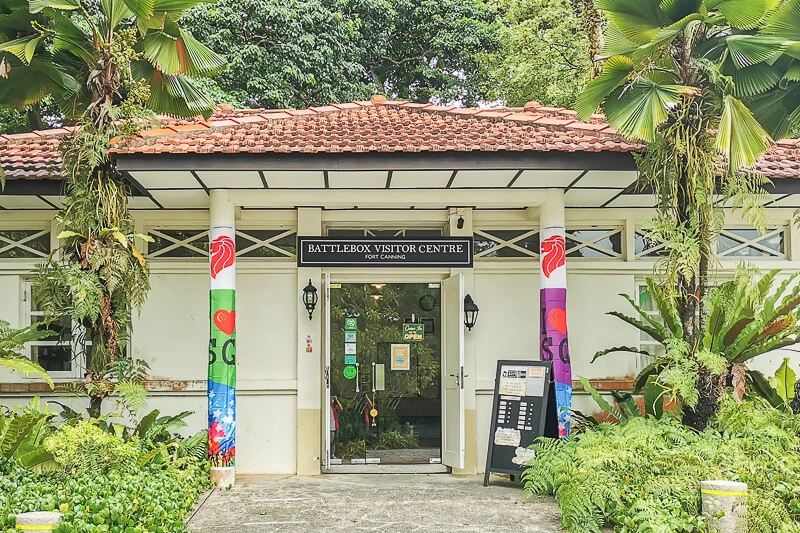
Fort Gate
Fort Gate was the entrance of Fort Canning fortress built in 1961. The fort originally had a wall and moat running around its perimeter. Today, only a small fragment remains. And this Fort Gate is one of the remnants of the old Fort Canning.
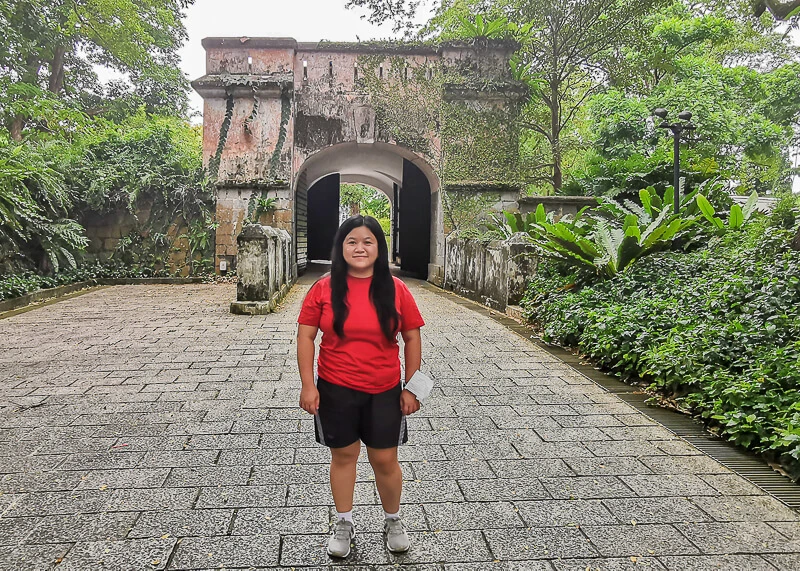
You can go up to the top of the Fort Gate by climbing a narrow staircase. Even though it’s just an empty rooftop, it’s worth the climb.
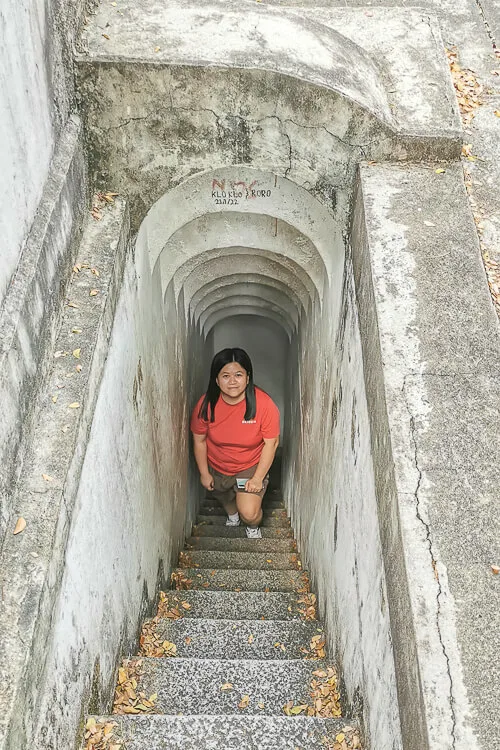
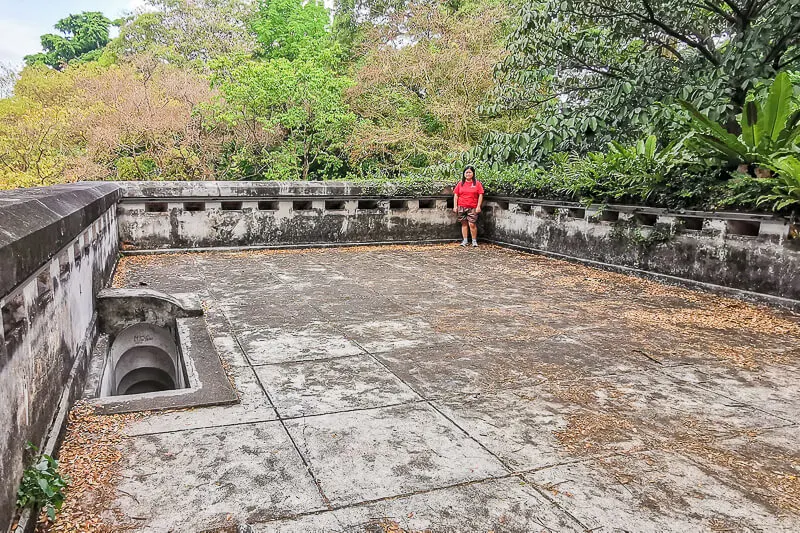
Next to the Fort Gate, you will find a map on the floor that illustrate the floor plan of the Fort Canning in the past.
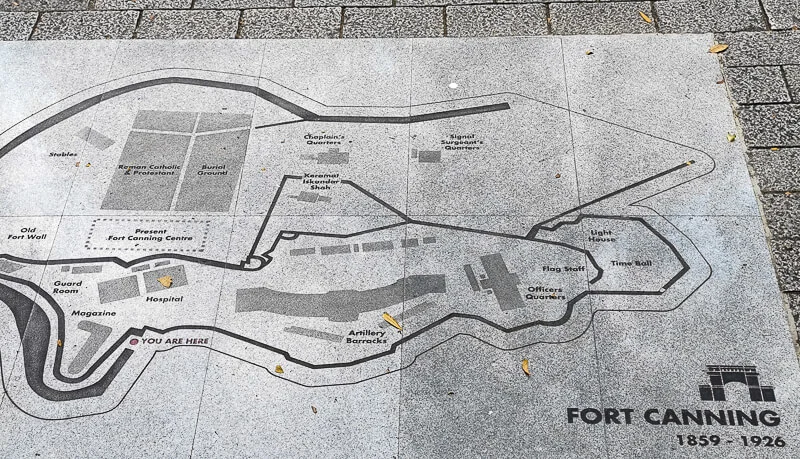
Battlebox Escape Shaft
This shaft is an escape shaft from the Fort Canning Bunker (now known as The Battlebox). During the war, this structure was camouflaged to hide it from the enemy.
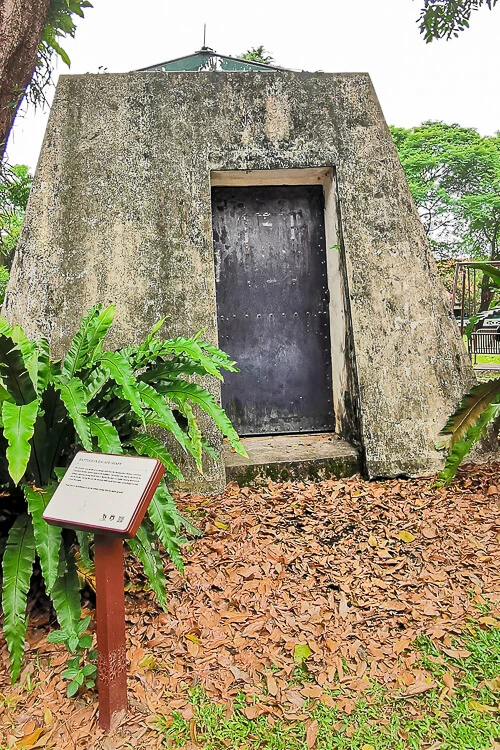
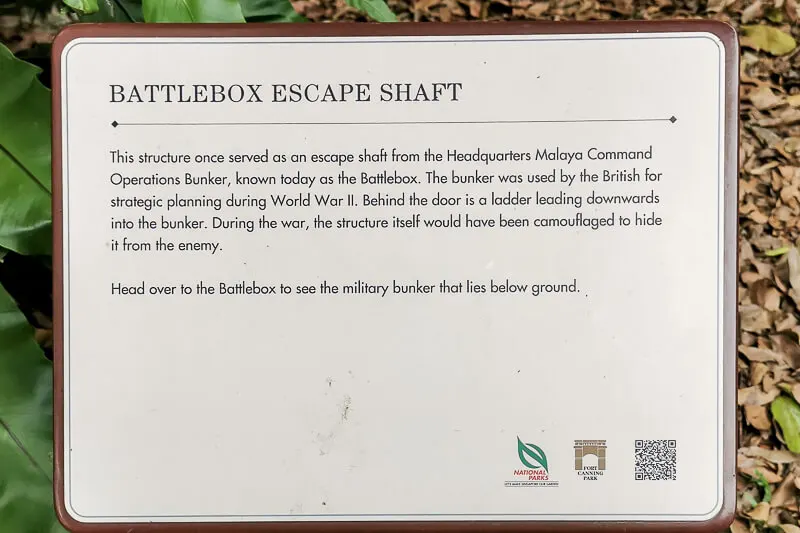
Old Married Soldiers Quarters (OMSQ)
Built around 1926, the Old Married Soldiers Quarters was as a place where married British army officers lived.
Today, the OMSQ is a venue for small concerts, weddings and other events. Bookings can be done via NParks’ website.
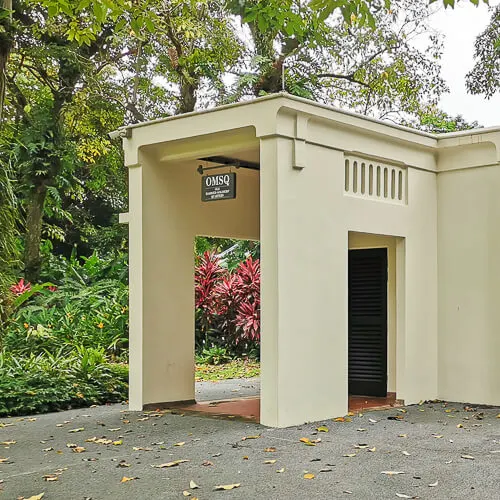
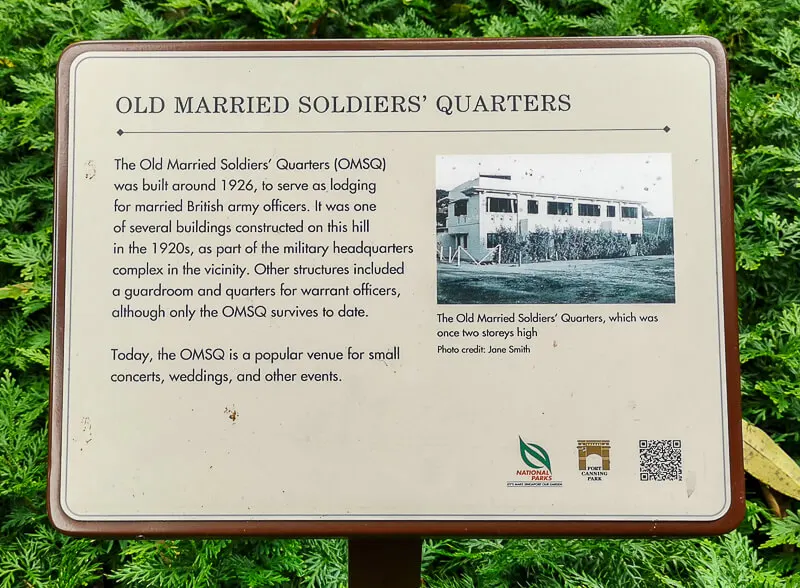
Pancur Larangan
Pancur Larangan means Forbidden Spring. The spring was believed to be the bathing place of Malayan king’s wives and consorts in ancient times. It was one of the most restricted areas in the palace, hence the name.
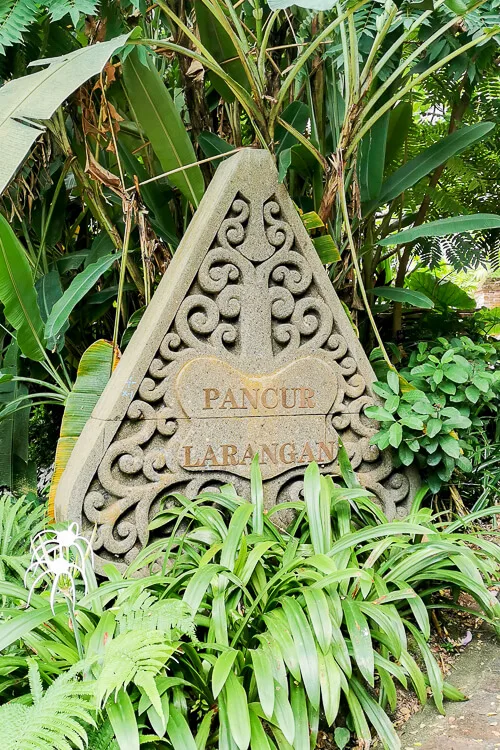
In the 1819, the British built aqueduct to transport water from the spring to Singapore River to supply drinking water to ships visiting Singapore until 1830. The spring soon dried up.
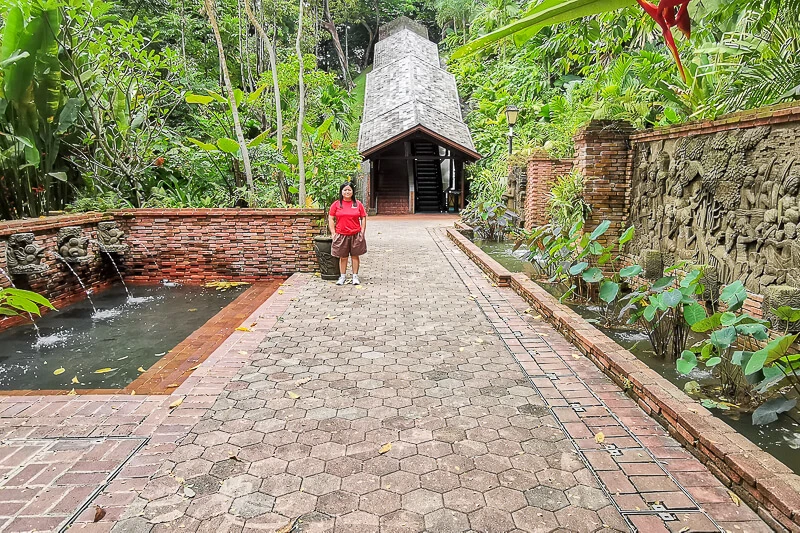
Today, the beautiful water garden at Pancur Larangan is an artistic representation of the ancient Forbidden Spring. It is decorated with ornamental water spouts and stone relief carvings depicting life in Singapore from 14th to 19th centuries.
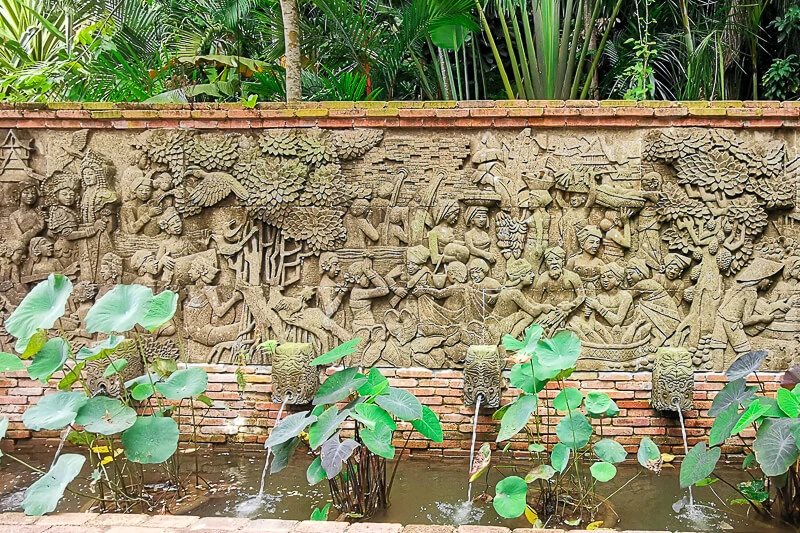
The design of this water garden was inspired by bathing places in Java. It does remind me of the Holy Springs of Tirta Empul in Bali.
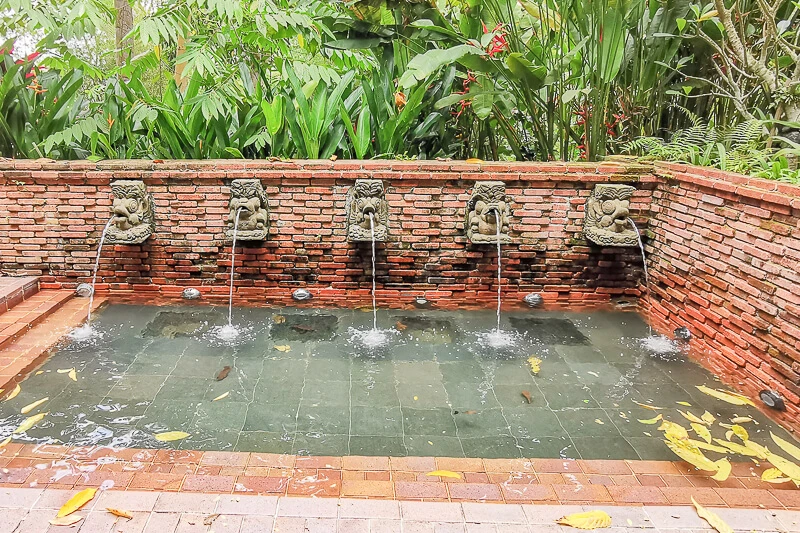
Raffles House
Raffles built his first residence in 1822 at the top of the hill. The bungalow was 100ft long and 50ft wide, with venetians and an attap roof. The house has a beautiful view of the Singapore River.
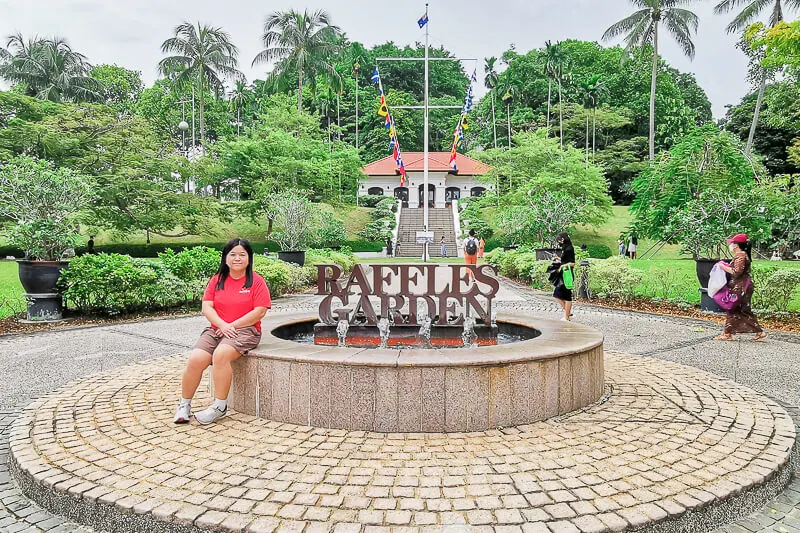
In 1859, it was demolished for the construction of a fortress which was named Fort Canning. A new Raffles House was reconstructed and opened in 2003.
Today, the modern Raffles House is an air-conditioned venue for events and weddings. Bookings can be done via NParks’ website.
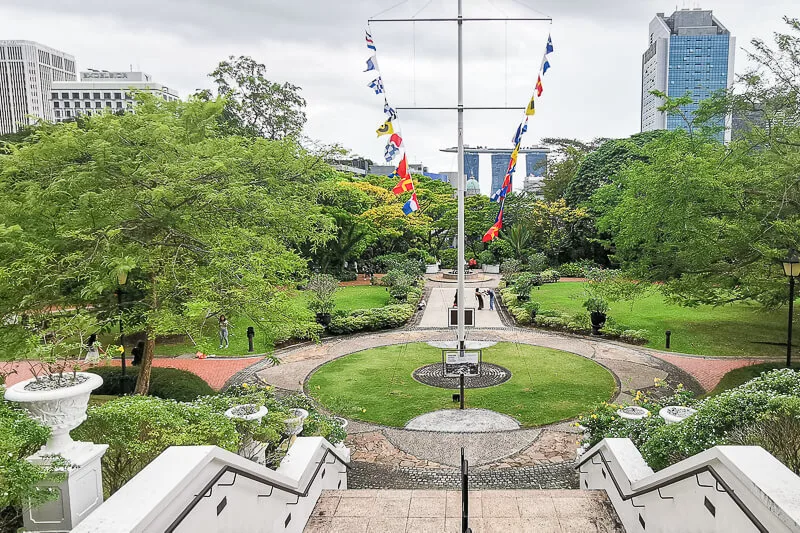
Time Ball
Next to Raffles House stands the replica of the original time ball that was previously installed on the same site. The original time ball was used to signal the correct time to the public.
In the past, the time ball was raised at 12.55pm each day, and dropped down exactly at 1pm. This helped people living and working in the downtown area to set their clocks to the correct time.
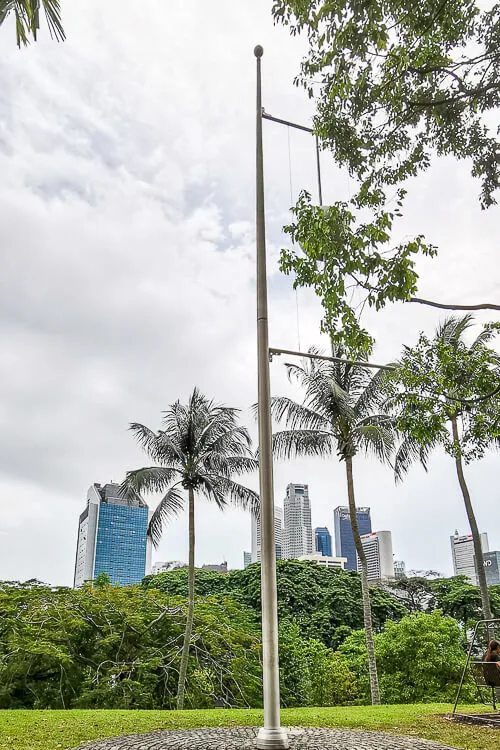
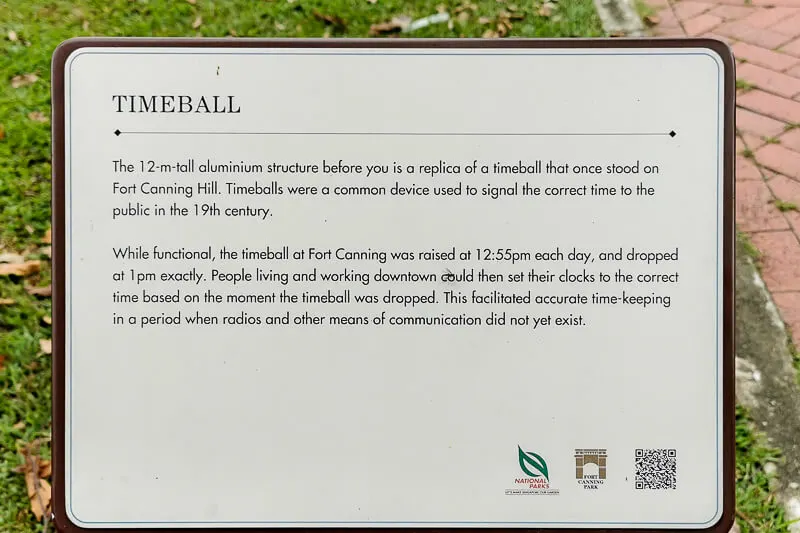
Fort Canning Flagstaff
In front of Raffles House is a replica of the original Flagstaff that was used as communication tool for shipmasters and merchants.
The various flags fluttering on the flagstaff was used to communicate various messages and information about the arrival, identity, location, and status of ships entering Singapore harbour.
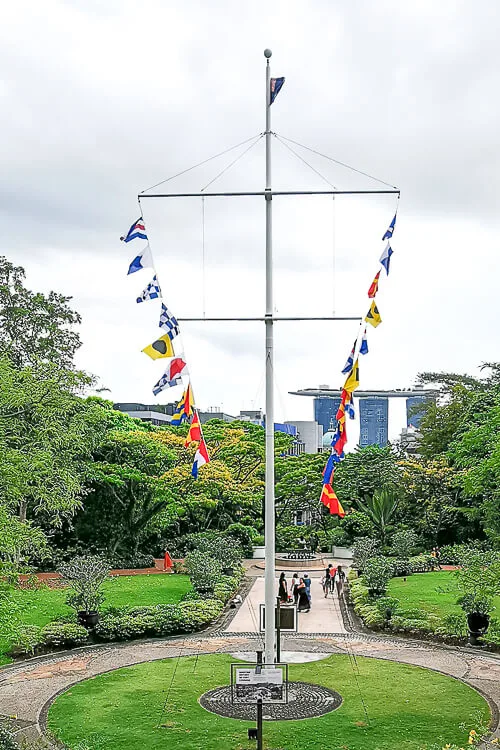
Fort Canning Hill Mural Wall
Make your way down the staircases near the flagstaff and you will find nicely carved mural walls on the sides of the staircase.
These sandstone mural carvings depicts scenes in Singapore between 14th and 18th century, before the colonial period.
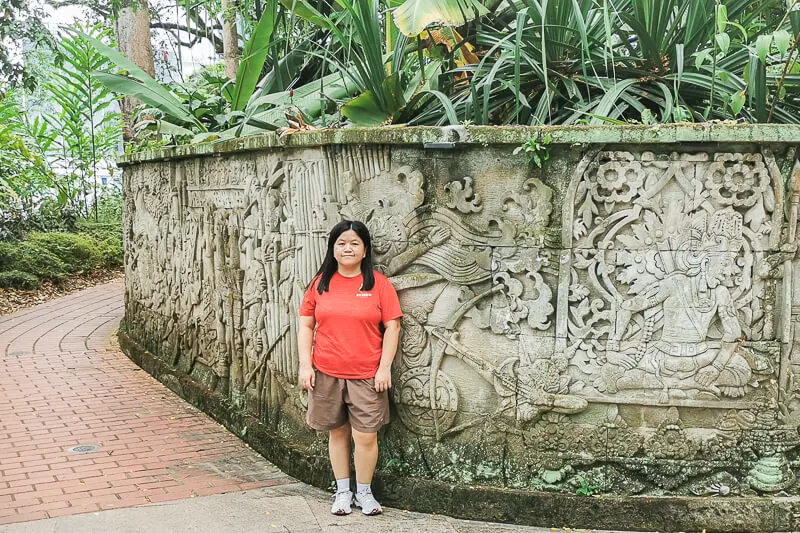
The murals were designed and created by Mr Eng Siak Loy. They were carved on Brexi stones by sculptors in Bali, and then shipped and assembled in Singapore.
It’s easy to miss out these walls if you’re only looking straight when going up or down the stairs, so, keep a lookout at the staircase landing.
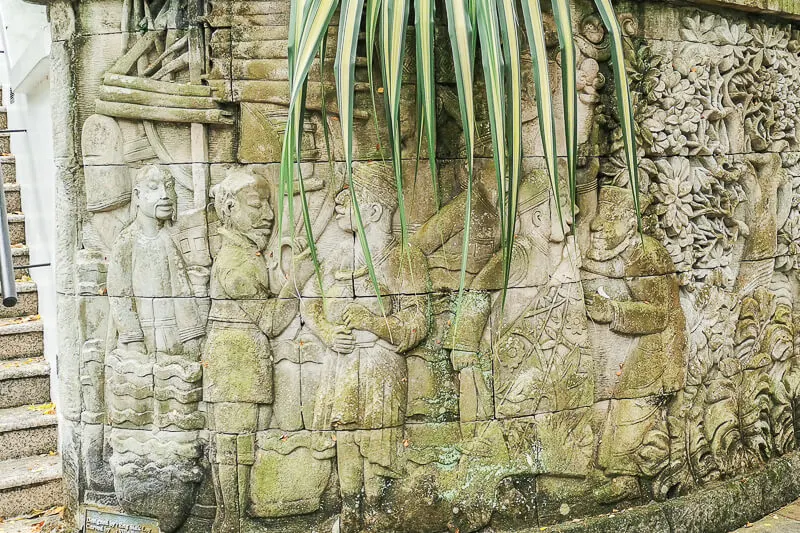
Fort Canning Lighthouse
Next to the flagstaff, you will notice the unmissable Fort Canning Lighthouse. This lighthouse is a smaller replica of the original lighthouse that was built in1903.
The total elevation of 60m (which is the combined height of the hill and lighthouse) made the lighthouse visible from 30km away.
In 1958, the original lighthouse was closed and dismantled because it was overshadowed by tall buildings.
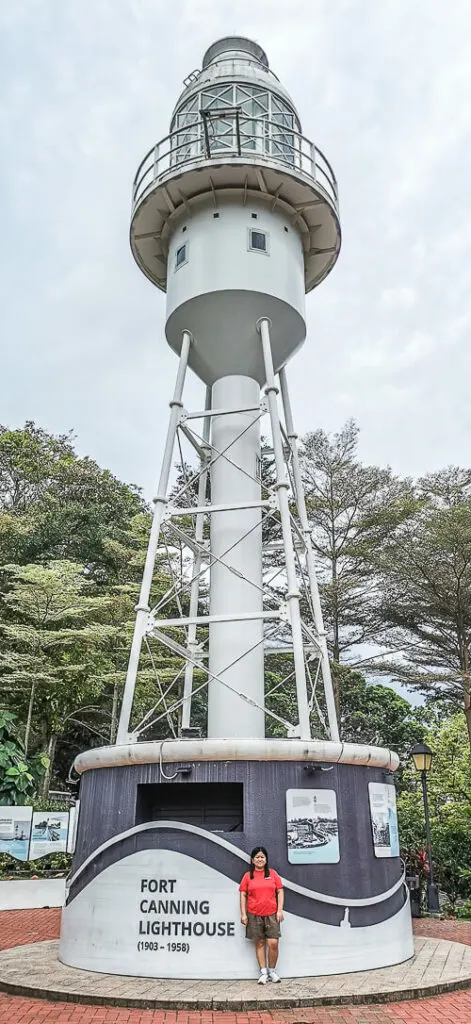
Sang Nila Utama Garden
Sang Nila Utama Garden gained popularity because of the Javanese split gates that are commonly found in Bali architecture.
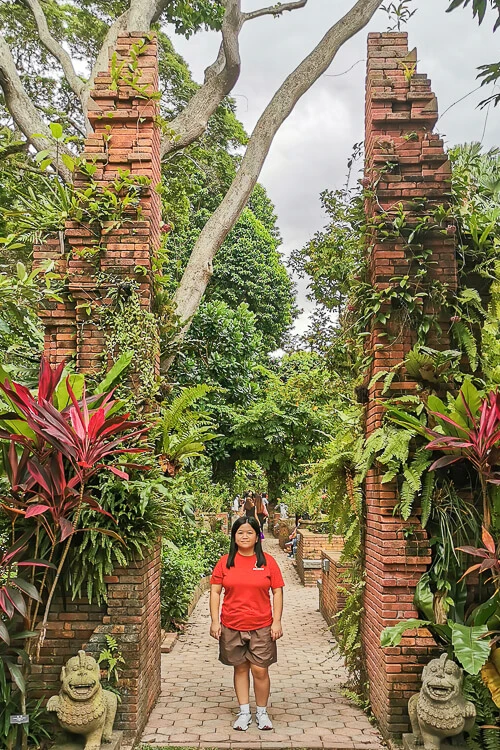
But, Sang Nila Utama Garden is actually a re-imagined ancient royal garden that was once located on this hill. It was named after Singapore’s first king and legendary founder, as recorded in the Malay Annals.
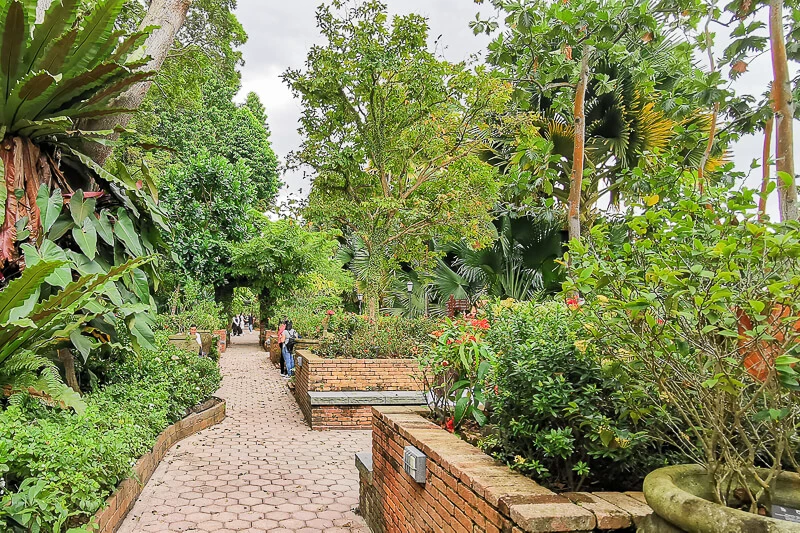
This tranquil garden has a symmetric layout and reflective pools filled with lily pads. It was believed to be used by king to meditate or to entertain guests.
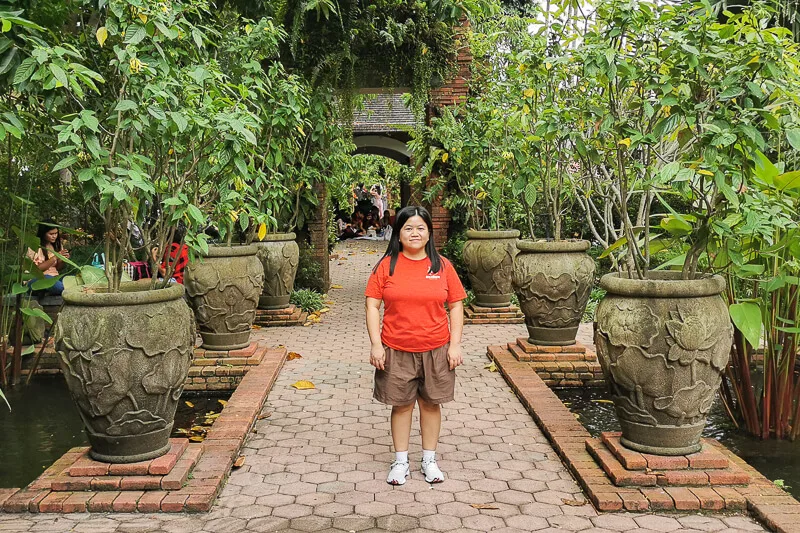
9-Pound Cannon
The 9-pound cannon was erected in the early 19th century. It had become obsolete before the Fort was built in 1859, therefore, it was used only as decoration for the main gate of Fort Canning.
The cannon was reckoned to be used at Scandal Point, an earlier fortification at the east end of the Padang.
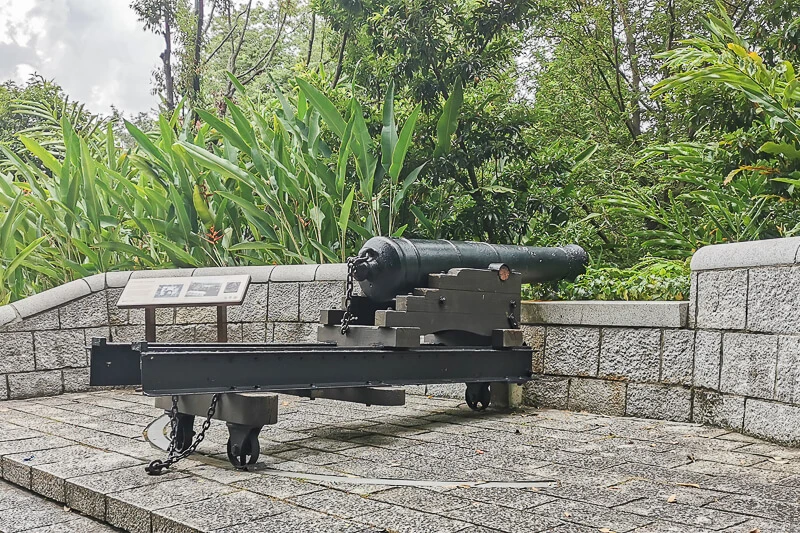
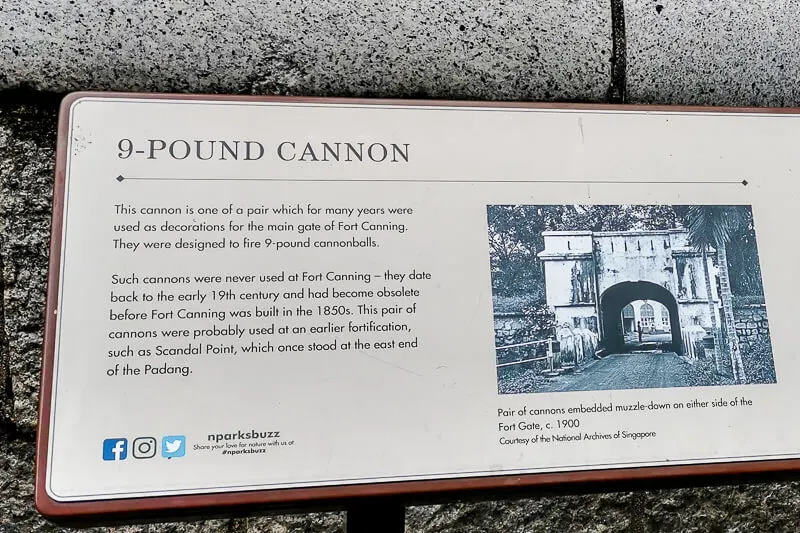
Fort Canning Centre
Built in 1926, Fort Canning Centre was used as British Army barracks. Over the years, the Centre has been repurposed into various functions, including squash courts, offices, and arts centre.
Today, Fort Canning Centre is home to Fort Canning Heritage Gallery. Admission is free for everyone. The gallery is open from 10am to 6pm daily (except the last Monday of each month).
The Heritage Gallery features the rich history and heritage of Fort Canning Park since the pre-colonial days. There are also historical artefacts, interactive exhibition and a mini-theatre.
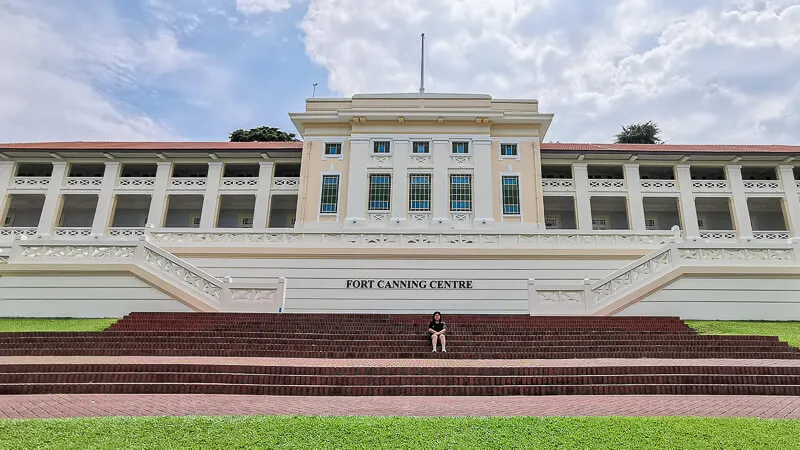
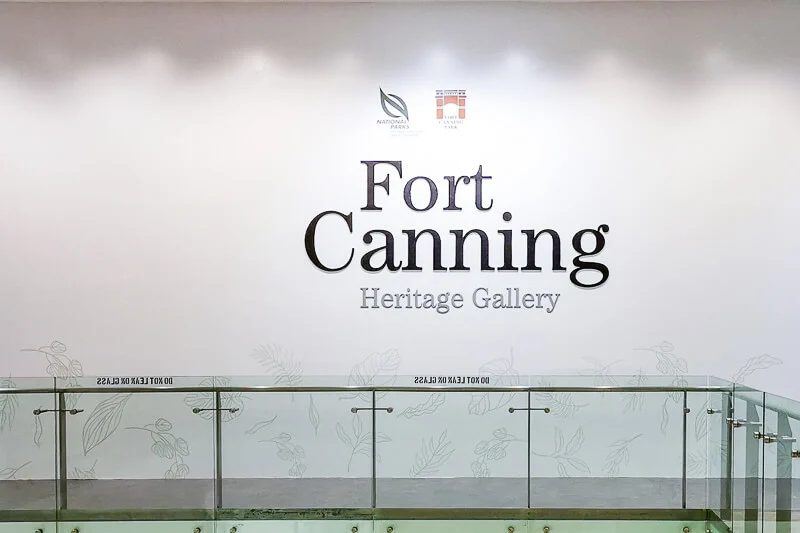
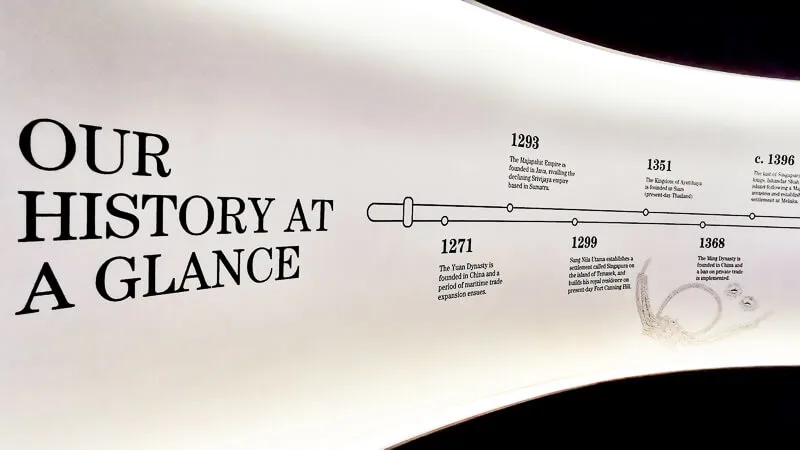
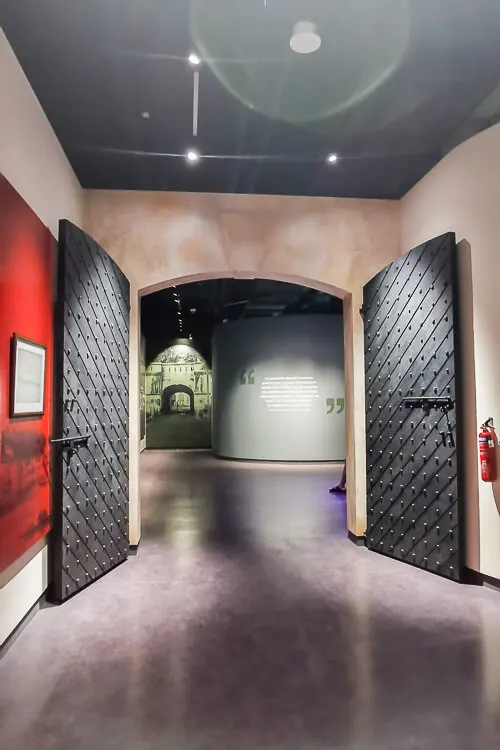
One of my favorite exhibition is the Flagstaff Signals. Before this, I couldn’t image how the Flagstaff at Raffles House could be used to communicate information about ships entering Singapore’s harbor in the past. Now it finally makes sense to me!
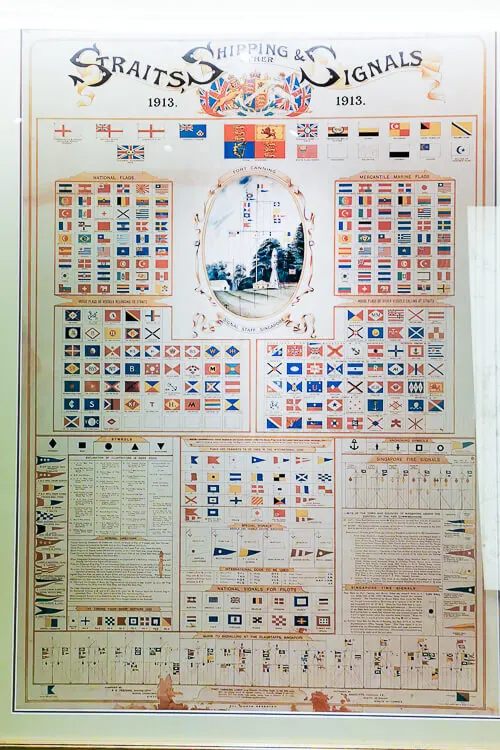
Another exhibition I enjoyed is this interactive exhibition about Japanese troop advancement into Singapore. You can click the date and you’ll see how the Japanese troop advanced each day.
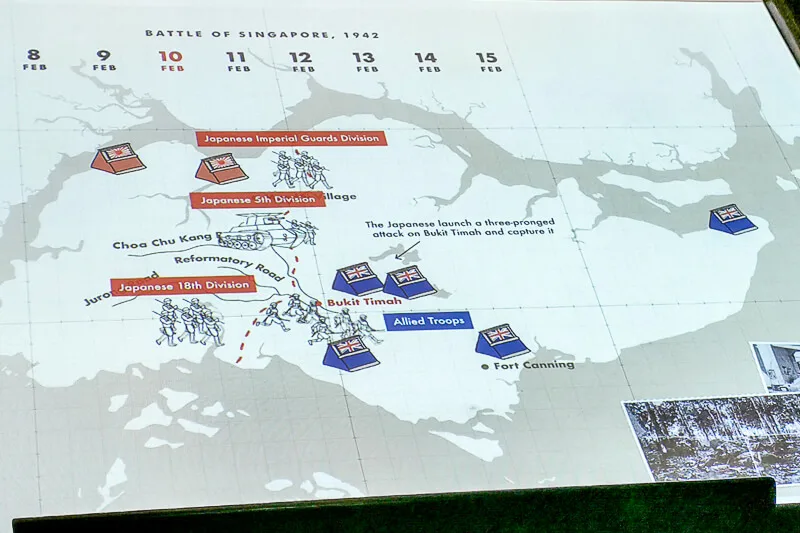
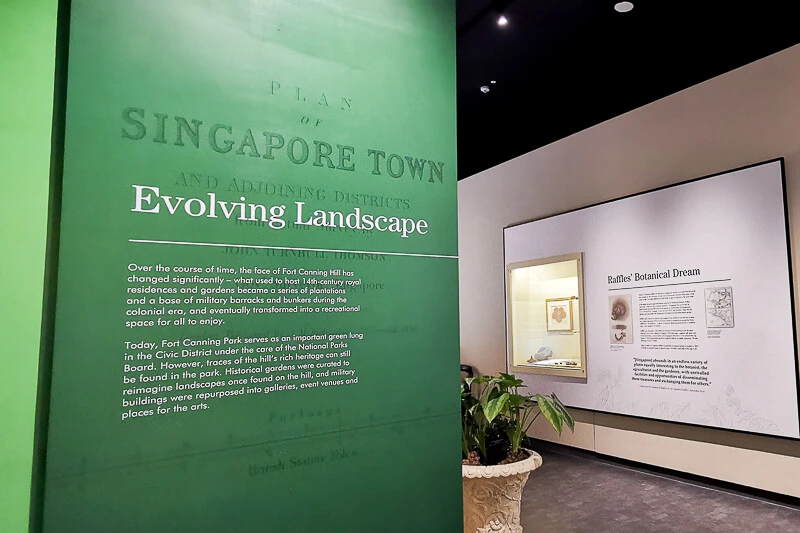
At Level 3, there’s this miniature of Fort Canning Park that’s showing the present layout of the park. It feels fascinating to be able to see the entire park before your eyes!
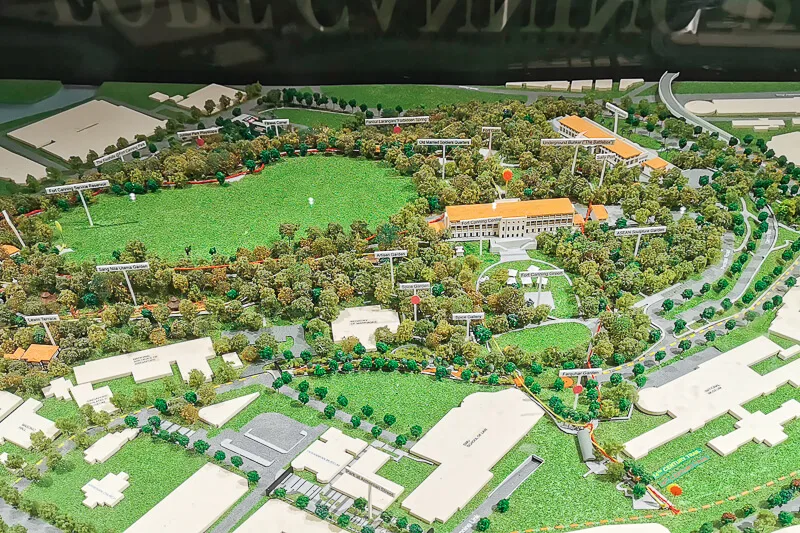
Fort Canning Green
Fort Canning Green is a lawn located at the back of Fort Canning Centre. It is an event space which can hold up to 11,500 people. Bookings can be done via NParks’ website.
When not used as event space, the lawn is a great photo spot to capture the entire Fort Canning Centre building.
At Fort Canning Green, there are Twin Cupolas (dome-shaped shelters) standing side by side. They’re designed by Mr. George Coleman, a prominent architect and Raffles’ consultant on the first Town Plan. The cupolas are probably meant as places for rest and contemplation on the hill.
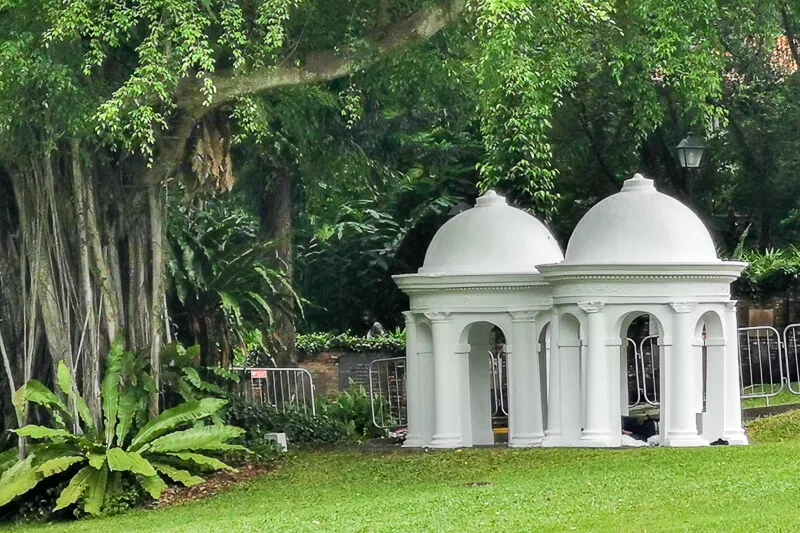
First Christian Cemetery
The entire ground of Fort Canning Green was the First Christian Cemetery. This burial ground was used from 1822 to 1865. You can find the headstones along the boundary wall.
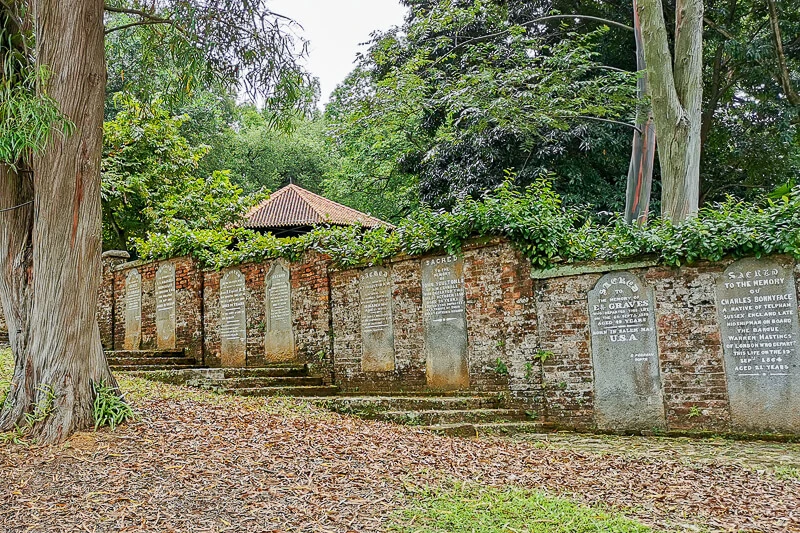
Gothic Gates
There are two Gothic Gates that serve as the entrances to the Old Christian Cemetery. These were designed by Captain Charles Edward Faber, a Superintending Engineer.
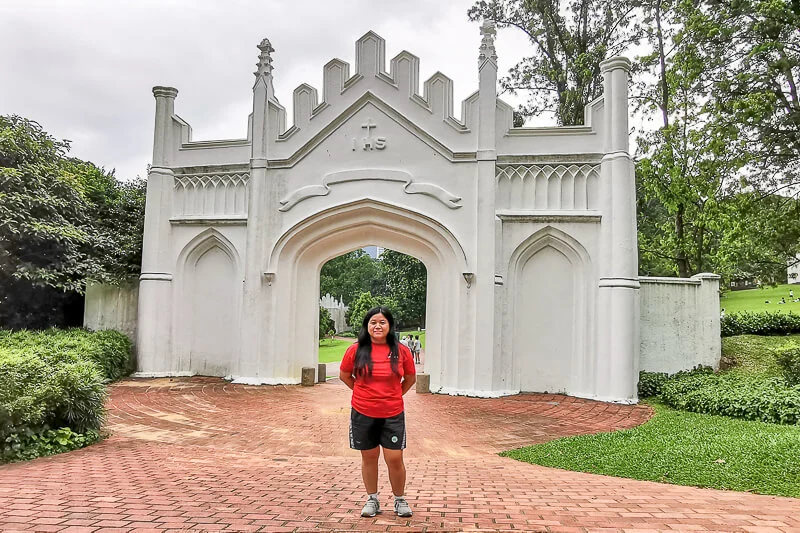
Keramat Sultan Iskandar Shah
Keramat Sultan Iskandar Shah is a shrine dedicated to Sultan Iskandar Shah, the last of the five kings who ruled Singapore in the 14th century.
When Singapore fell to enemy attack, Sultan Iskandar Shah fled to Malaysia and founded a new kingdom at Malacca.
He passed away around 1420s. There was no record of where he was buried. But locals believed that he was buried on this site.
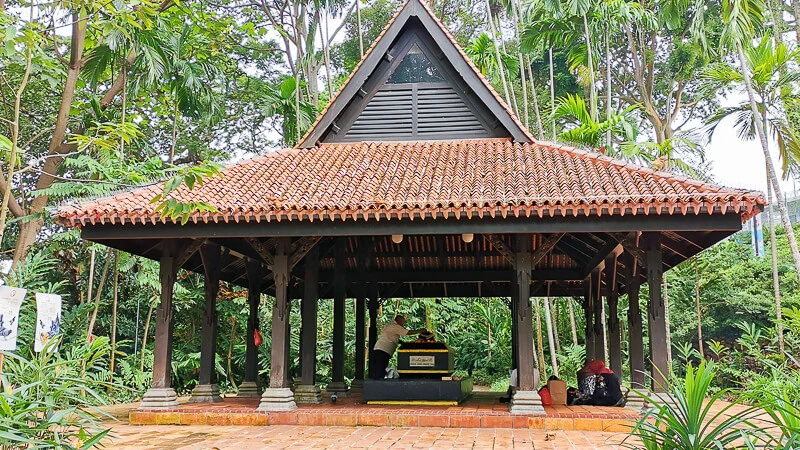
Artisan’s Garden
Artisan’s Garden is believe to be the site of an artisan’s workshop and living quarter during the 14th century. Craftsmen lived and worked here, making fine goods for the royal family living on the Forbidden Hill.
Excavation at this site uncovered workshop tools and thousands of artefacts, revealing evidence of a former workshop.
At the center of Artisan’s Garden is a display showing the four layers of soil at this site, which suggested that the site was used by human in the 14th century and then abandoned until early 20th century, when brick houses were built here for the lighthouse keepers.
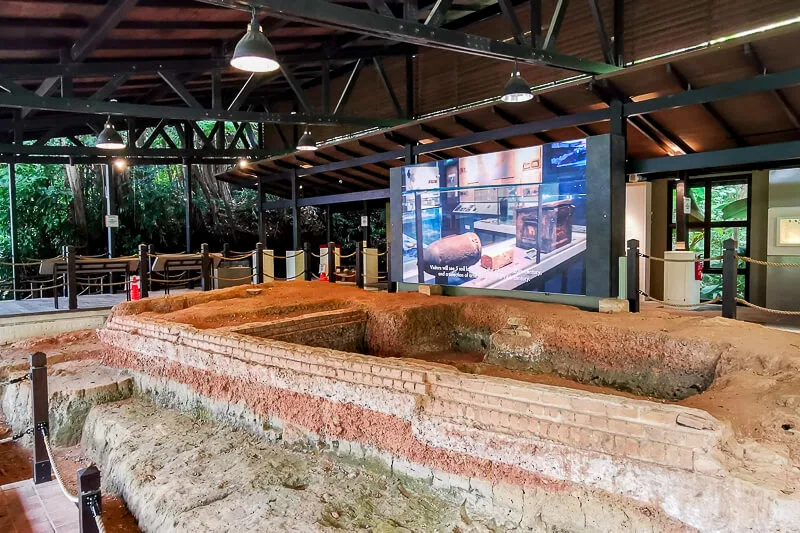
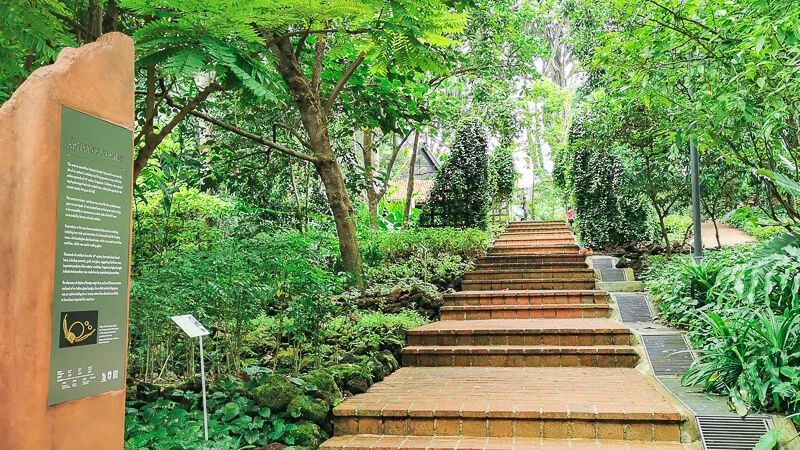
Spice Garden & Spice Gallery
The Spice Garden is about 3,200 sqm in area, and has over 180 varieties of spice plants. There is also a Spice Gallery at the bottom of the ramp featuring early history of spice plantations in Singapore.
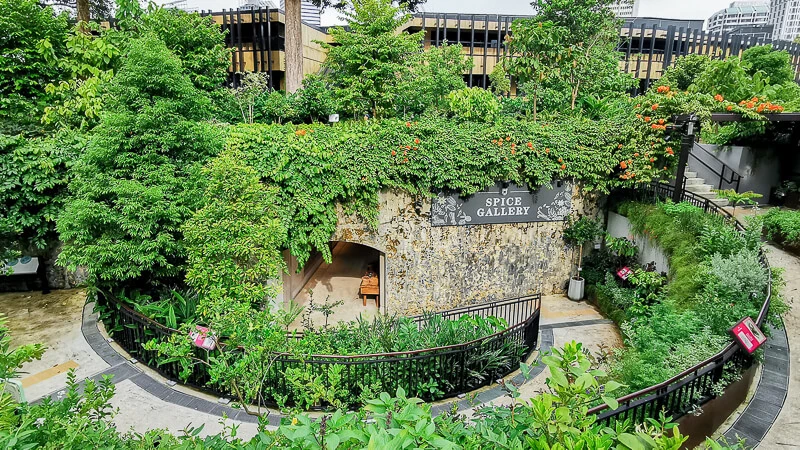
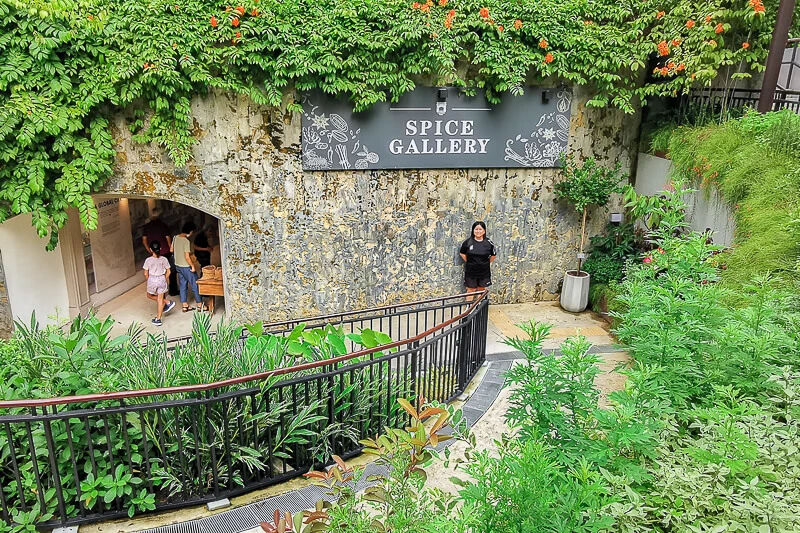
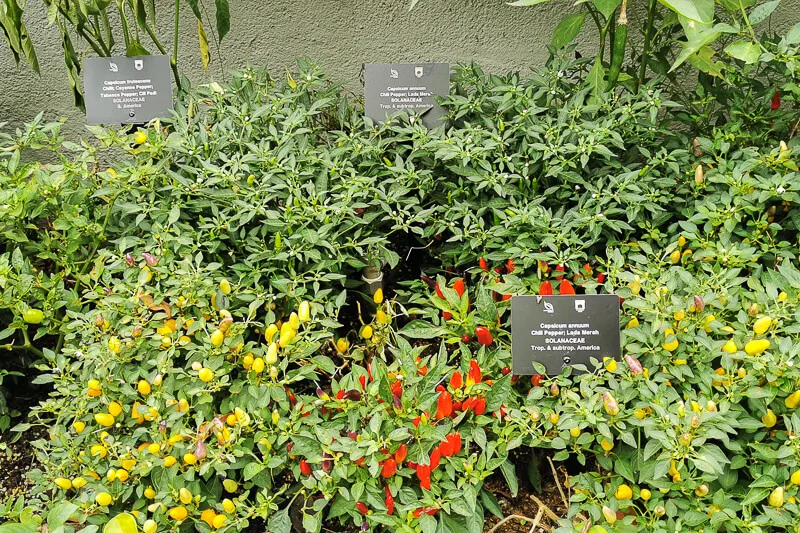
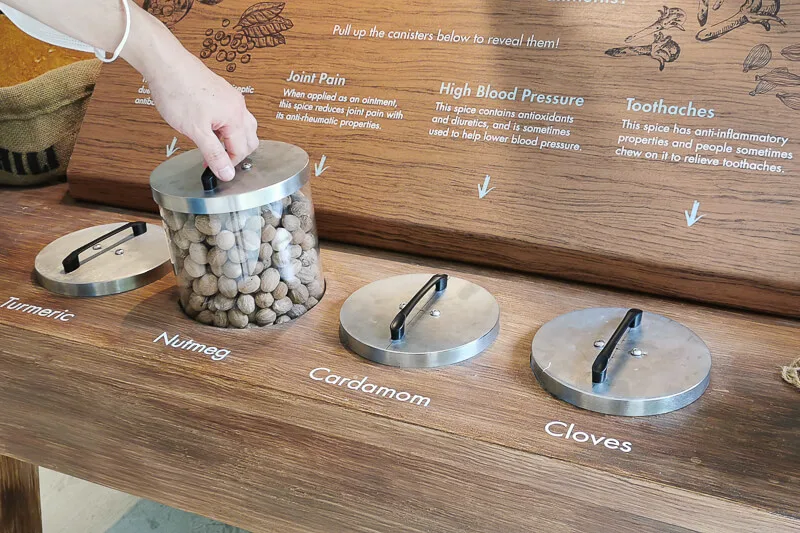
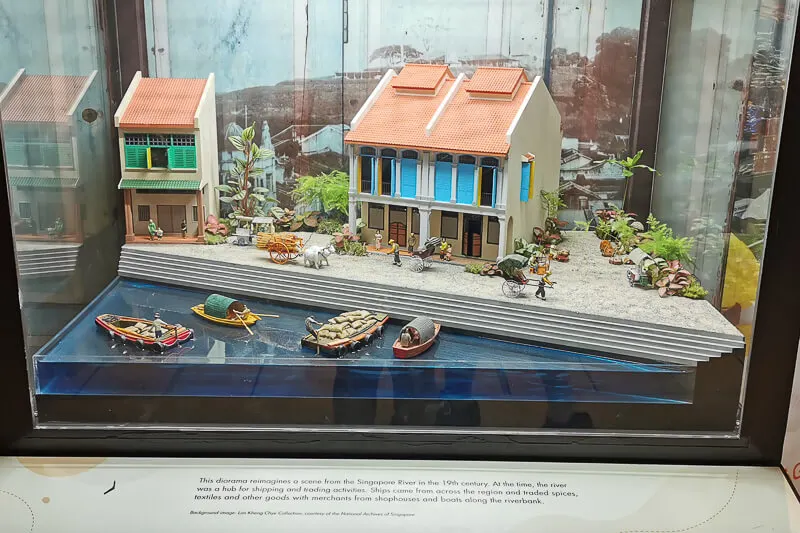
ASEAN Sculpture Garden
The ASEAN Sculpture Garden was opened in Fort Canning Park in June 1982. There are 6 sculptures in this park, namely: Unity, Taming Sari, Fredesvinda, Concentration, Balance and Together.
These sculptures are the works of artists from Indonesia, Malaysia, the Philippines, Thailand, Singapore and Brunei.
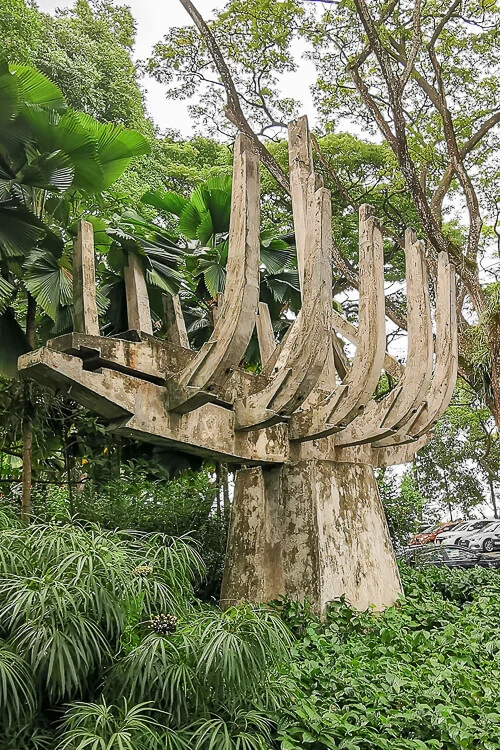
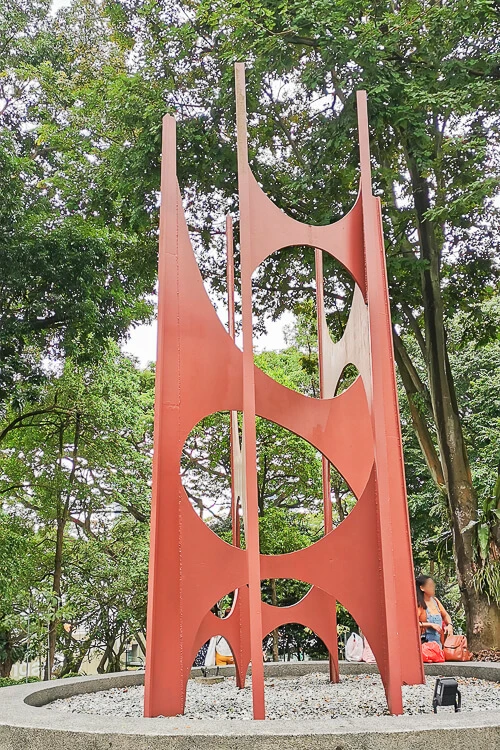
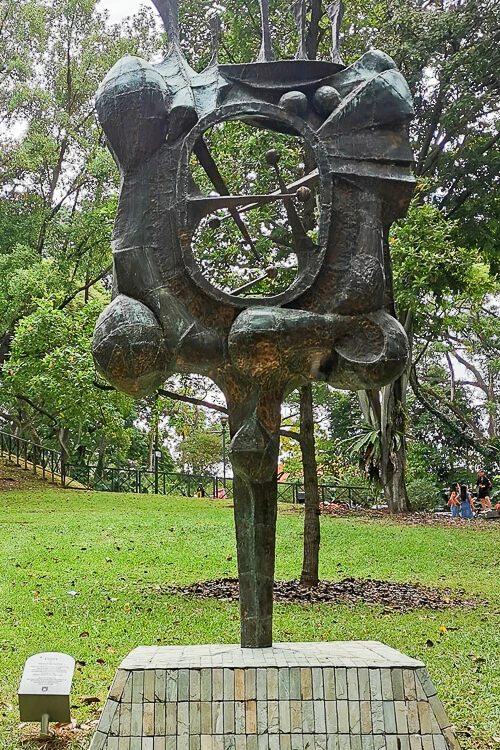
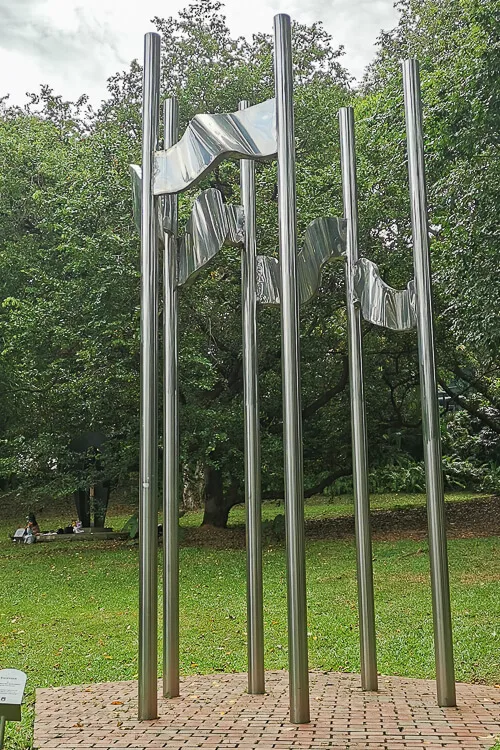
Fort Canning Service Reservoir
The Fort Canning Service Reservoir is not exactly a place you can visit. You can see it but you can’t enter because it’s a restricted area.
In case you’re wondering what this reservoir is all about, here’s a brief story about the reservoir.
The Service Reservoir was built in 1929 to supplement water supply in the vicinity areas. Its water sources used to come from Woodleigh and Johor.
Today, it collects water from Murnane Service Reservoir, Woodleigh Waterworks and Bukit Timah Waterworks; and supplies clean drinking water to the CBD, Marina Bay, Bugis, Lavender and Boon Keng, together with Pearl’s Hill Service Reservoir.
The reservoir is submerged most of the time and emptied once a decade for physical inspection. If you’re curious what it looks like on the inside, here are some photos taken during Prime Minister’s visit in 2021.
That explains why it’s not open for the public!
8. What to eat at Fort Canning Park
Tiong Bahru Bakery
Tiong Bahru Bakery is a well-known local brand serving comfort pastries and coffees. The restaurant is open from 7.30am to 7pm daily.
Their croissant is said to be freshly baked every two hours (I love their croissant!). Besides pastries, there are various cakes and sandwiches as well.
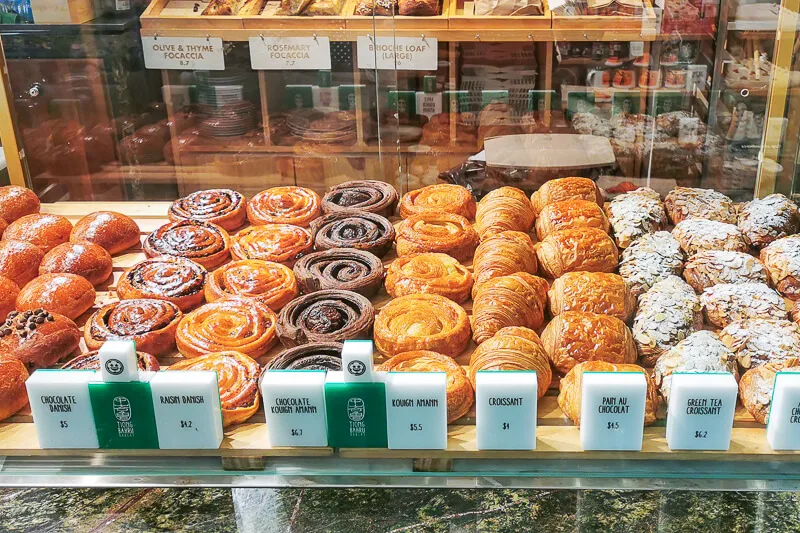
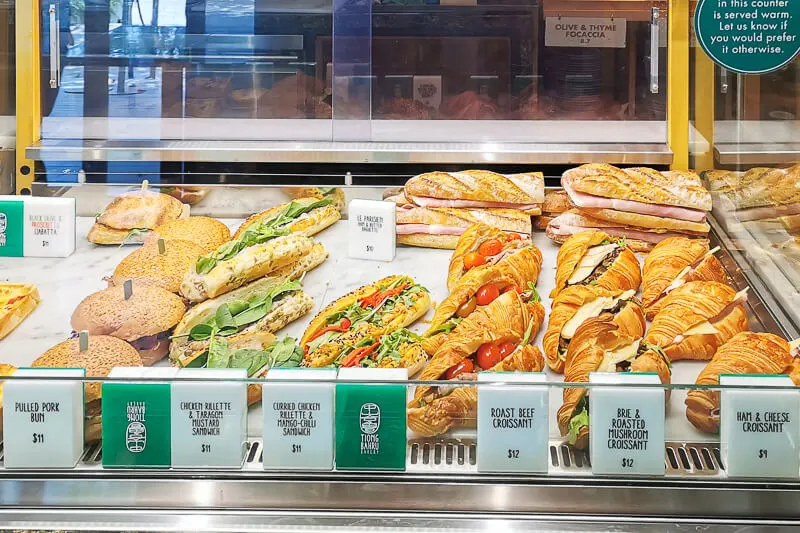
The building that Tiong Bahru Bakery occupies is the former River Valley Swimming Complex, hence, it is only fitting that the walls are decorated with swimming pool theme.
Located at the Foothills, the easiest way to reach Tiong Bahru Bakery at Foothills is to go to Fort Canning Park MRT Station and take Exit B.
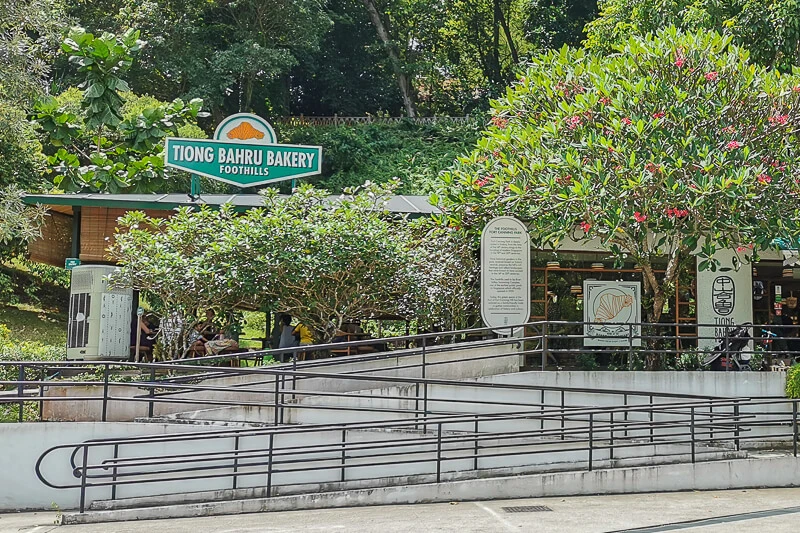
Le Jardin Restaurant
Le Jardin is a European restaurant serving French and European cuisine. The restaurant is open from 9am to 9pm on Mon-Fri; and 8.30am to 9.30pm on Sat-Sun.
They offer Brunch menu from morning until 5pm, and Dinner menu from 5.30pm until closing. Pets are welcome at their outdoor seating.
As the name suggests, Le Jardin (which is a French word for “garden”) has amazing garden interior that makes you feel like you’re dining inside a beautiful garden.
Le Jardin is located at Fort Canning Centre. If you’re taking public transport, the easiest way to reach the restaurant is to come via Tree Tunnel entrance or Stamford Green entrance (read “How to get to Fort Canning Park” section above).
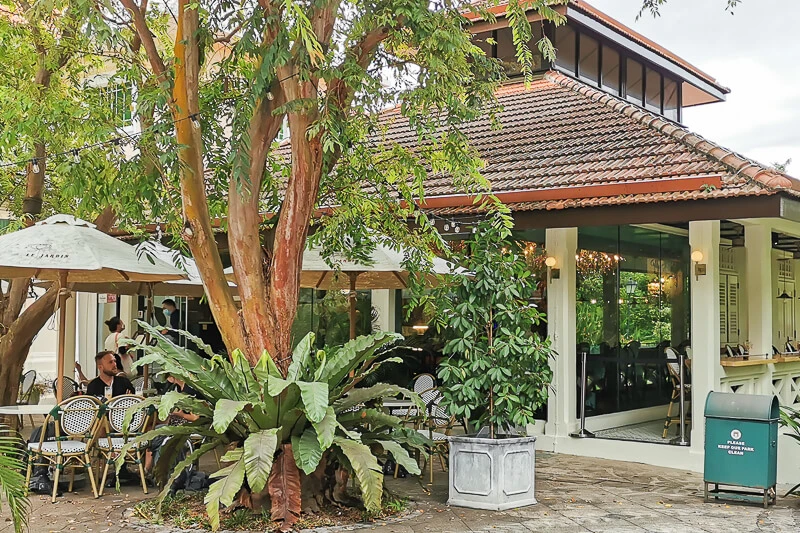
Fort Canning Hotel
There are 2 dining options at the Fort Canning Hotel, namely The Salon (7am-10.30pm daily) and Tisettanta Lounge (11am-10.30pm daily).
The Salon serves breakfast buffet in the morning. In the afternoon and evening, you can expect local fares (such as Lobster Nasi Lemak, Hokkien Mee) and international cuisines (such as Chorizo Seafood Pasta and Truffle Mushroom Pizza).
Tisettanta Lounge is a laid-back lounge serving beverages, from coffee and tea to cocktail and wine.
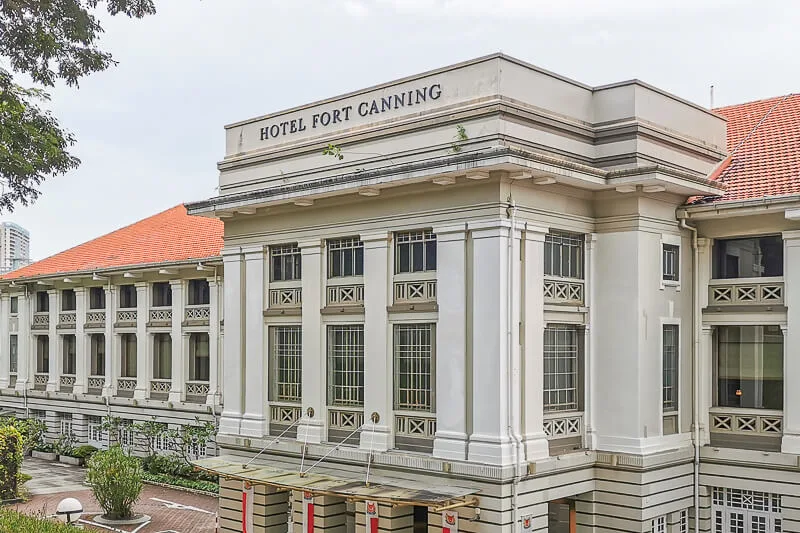
9. Nearby Places of Interest
Museums
National Museum of Singapore is the oldest museum in Singapore, dating back to 1887. NMS provides various exhibitions, from history of Singapore to modern art installations.
NMS is just a few steps away from Gothic Gate and ASEAN Sculpture Park. Admission is free for Citizens & PRs. For others, admission starts from S$10 (Child/Senior) and S$15 (Adult). You can get discounted ticket by booking here.
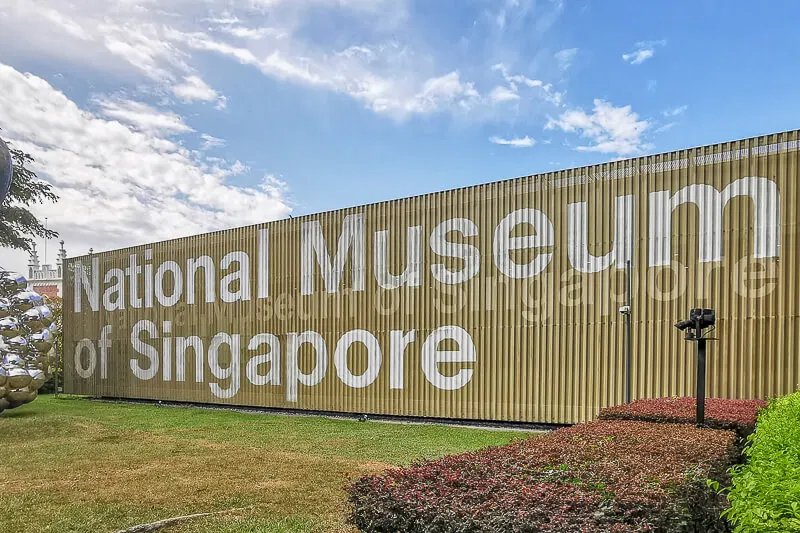
Children’s Museum Singapore and Peranakan Museum are a couple of minutes walk away from Fort Canning Park, but both are currently undergoing renovation (as of 2022).
Old Hill Street Police Station
Old Hill Street Police Station is a famous IG-worthy photo spot because of its colorful windows. Formerly a police station, the building now serves as office for Ministry of Communications and Information (MCI) and the Ministry of Culture, Community, and Youth (MCCY).
It is located at the junction of Hill Street and River Valley Road. To get here from Fort Canning, head to Raffles House and walk down a series of staircase where Mural Wall is located at.
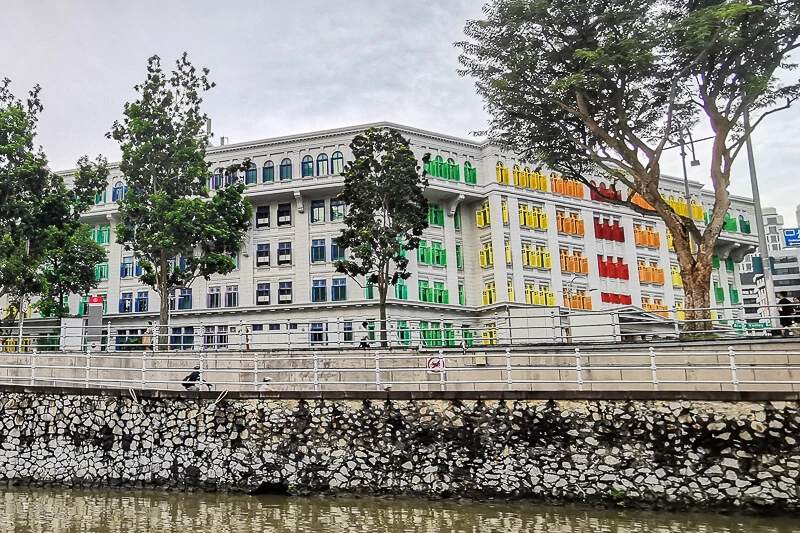
References:
The Legends Fort Canning Park
Infopedia – Fort Canning Park
NLB – Fort Canning Bunker
The Straits Times – Garden hopping in Fort Canning Park
Roots.sg – The Fredesvinda sculpture at Fort Canning Park
If you like my work, you can buy me a coffee! Your support will help me to keep going!

